How the Blind Burners collective opened pathways for non-visual access to virtual reality — from Burning Man to beyond
By Harsha Balasubramanian and Chris Hainsworth
Building Non-Visual Access to Virtual Reality
“VR does not stand for visual reality.” This is a mantra for Blind Burners: an international collective of artists formed around a shared desire for self-expression in virtual reality and an ethos of inclusive production processes.
VR continues to make progress with innovations in visual fidelity, hand controllers and wireless headsets, while simultaneously excluding blind and low vision creators and audiences. In Summer 2021, as part of virtual Burning Man, Blind Burners’ collective of blind, low vision and sighted artists gathered to create their own virtual worlds in which to explore non-visual access, producing an art gallery and a Temple of Accessibility.
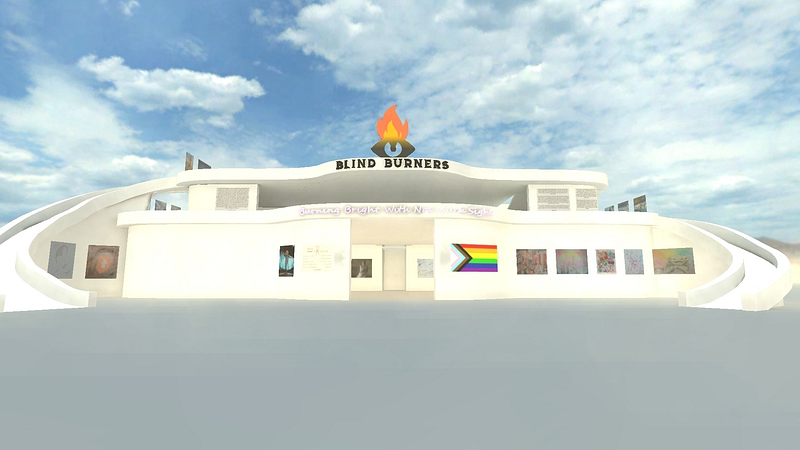 Blind
Burners Art Gallery — created with support from Big Rock Creative for BRCVR, an Official Burning Man
Experience in 2021
Blind
Burners Art Gallery — created with support from Big Rock Creative for BRCVR, an Official Burning Man
Experience in 2021Whilst Burning Man’s temples for many are a powerful contemplative experience focused on spiritual cleansing or psychological release, our Temple of Accessibility was an attempt to playfully call “bullshit” on Burning Man’s claim to “radical inclusion” in its ten principles. Given the wealth, connections, and day-jobs of so many in the Burning Man-Silicon Valley Tech Nexus, it is extraordinary that digital accessibility was so absent from planning for 2020’s digital burns.
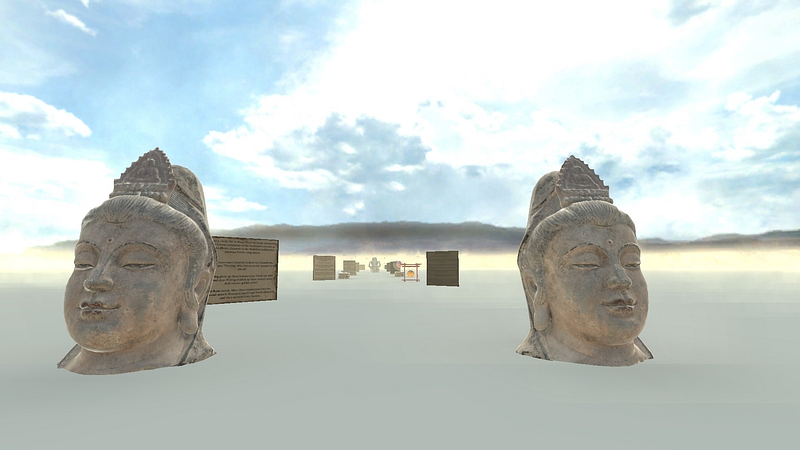 Blind
Burners’ Temple of Accessibility
Blind
Burners’ Temple of AccessibilityInspired by the art piece Futures Past (2012) by Kate Raudenbush and its juxtaposition of ancient wisdom with modern technologies, we decided to build our own humble stone temple Burning Man offering. We offered our experiences trying to access food delivery apps, dating apps and creator tools, sharing how our attempts to find food, love and opportunities for self-expression were met by barriers. We shared examples of apps which are incompatible with screen readers, one of the most revolutionary inclusive technologies of our time. We strove to tell stories of digital exclusion in the hope that some of the tech gods who bestride Burning Man might listen and wield their power to remove these barriers.
Ahead of launching a re-developed version of our VR world in 2023 (the live version linked in this article is very much “undergoing renovation”), the build team assembled ’round our Zoom campfire to share inspirations and lessons learned from the initial build process.
The Initial Challenge and Strides Forward
Blind Burners World was built originally for AltspaceVR, a social VR platform experienced both in 2D through the desktop application and in 3D via a VR headset.
For users who require non-visual feedback, such as through a screen reader, there are currently no viable solutions for launching VR apps like AltspaceVR, for setting up headsets or using creator tools to design their own VR experiences.
The failure of AltspaceVR to work with screen readers meant that even the 2D version of our world could not be logged into and explored independently. Team members who used screen readers had to allow others to take control of their computers via remote access simply to enter the platform: an egregious security compromise.
Our project goals, therefore, were just as much about hacking technologies as they were about tackling preconceptions around visual impairment.
Chris Hainsworth, Blind Burners’ UK Co-Founder and the project’s Creative Director, offers:
We wanted to represent diverse and powerful artists in this new medium; to playfully educate and inspire tech companies such as Microsoft and Unity, whose VR software and creator tools are broken and exclusionary; and to experiment in use of sound to navigate 3D spaces, foregrounding audio-led design and spatial sound as innovative, playful and creatively rich.
Why VR?
This is a question frequently asked of blind artists working with VR. The assumptions that VR is a visual medium, and that blind- and low-vision VR-accessibility are “hard problems to be solved later,” are pervasive.
As highlighted by our temple, access to VR is an increasingly necessary condition underlying our human right to access not only culture, but work, social and educational opportunities too. Beyond this, VR will provide rich opportunities for blind audiences and creators to innovate, as they regularly do in their daily lives.
Marimuthu (he/him), a blind photographer, poet and PhD student in India, reflects on how his movement tends to be restricted in physical surroundings due to unfamiliarity or fellow pedestrians offering unrequested assistance. In that vein, Marimuthu shares, “VR might give us freedom of movement which will do a lot of good for our confidence and… motivate ourselves to face real obstacles.”
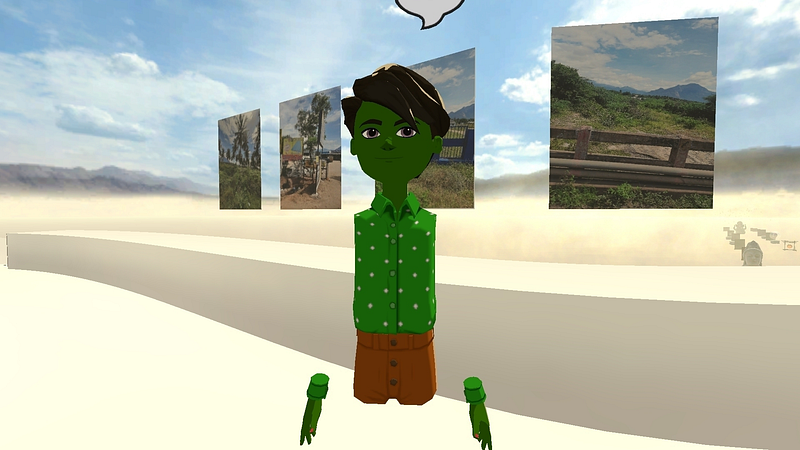
Ebony Rose Dark (‘All of the pronouns!’), who identifies as a proud, partially sighted, Black, gay Caribbean, non-binary performing artist and photographer in England, adds:
In a physical gallery I would be climbing up the wall to look at something really close. Or I use the magnification tool on my phone, zooming in to the picture, taking in the detail section by section. In VR, I can ‘zoom’ by walking closer to my photographs on the wall. It [feels] as if I [am] there in the space, so that is very exciting.
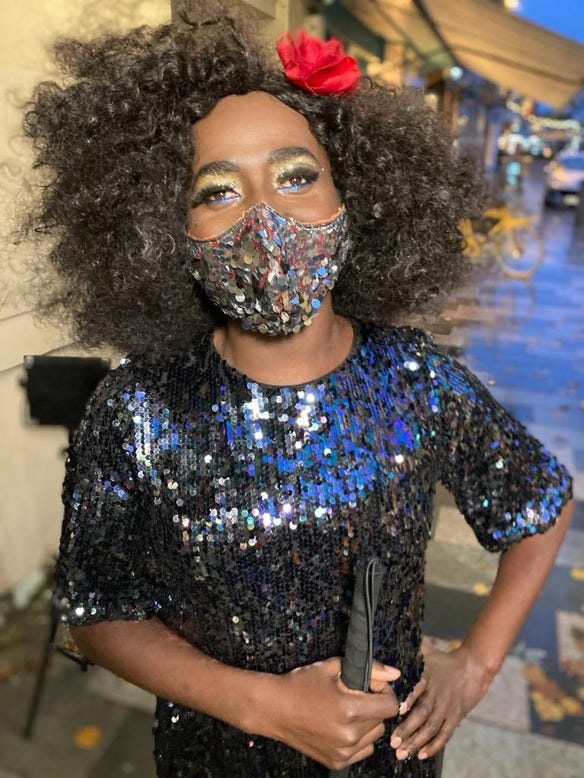 Photographer
and Performer Mickel, aka Ebony Rose Dark. Photograph by Graham Robson. This image appeared
on electric billboards and bus stops across Brighton & Hove during lockdown, with the caption
“Thank you for giving me space”.
Photographer
and Performer Mickel, aka Ebony Rose Dark. Photograph by Graham Robson. This image appeared
on electric billboards and bus stops across Brighton & Hove during lockdown, with the caption
“Thank you for giving me space”.Using Sound in the Place-Making Process
To showcase our art, we sought to create a welcoming gallery, modeled visually to reflect the grace, openness and curvature of contemporary art buildings such as the Los Angeles Getty Museum, and inspired above all by the innovative, multi-sensory inclusive architecture of the San Francisco Lighthouse for the Blind.
Whilst we hope that future projects will draw increasingly on tactile innovations, our current Blind Burners World is all about spatial sound.
Drawing on our team members’ experiences of navigating the world through use of sound, like when walking down a busy street or snowboarding down a mountain, we explored how a combination of non-verbal sounds and auditory descriptions could be deployed as guides.
Pathways to locations in the camp were assigned specific sounds. Users could select one sound from several options and follow it to progress down a path, and the selected sound would get louder as they neared the location while other sounds faded into silence. We chose everyday sounds that were easy to recognize and associate with specific places, such as a drum loop for the path to the gallery’s rooftop party area.
This multisensory environment was brought to life by Whitt Sellers (he/him), an NYC-based VR developer, and Adi Laflamme (they/them), a sound designer based in Canada.
As Adi recounts, “Putting sound first in design would provide opportunity for all kinds of different experiences that aren’t really possible right now, even though the technology already exists.”
We also placed directional prompts at entrances and along the paths. These excerpts were recorded in the voice of a screen reader, paying homage to this well-known component in blind individuals’ assistive technology arsenal. Artists wrote and recorded the audio descriptions for their own works.
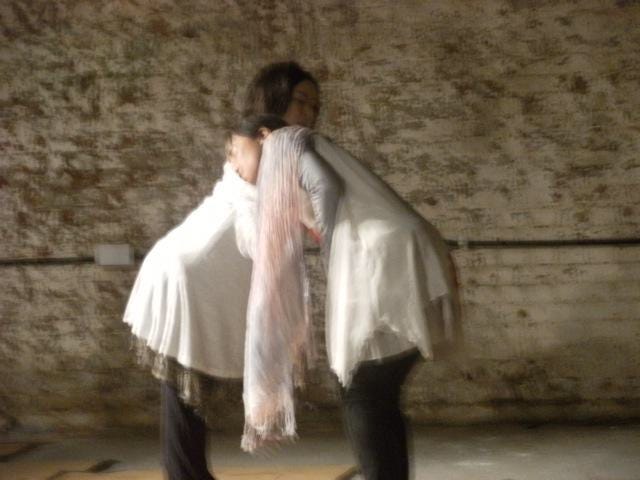 Dancers.
Photograph by Mickel aka Ebony Rose Dark, whose description of the image can be found in the Alt
text by hovering over the image.
Dancers.
Photograph by Mickel aka Ebony Rose Dark, whose description of the image can be found in the Alt
text by hovering over the image.Devising an Inclusive Production Process
During our six week sprint towards Burning Man 2021, our production process emphasized regular co-design and continuous user testing with blind, low vision and sighted artists.
One key access strategy we used throughout our project was Audio Description, the practice of verbalizing visual aspects in media content for blind and low vision audiences.
In our review meetings, we each described how we experienced the designs and content of our VR world and the user interfaces of the creator tools we were using. Rather than introducing description at post-production stage, as is standard for many accessibility initiatives, we did this throughout the development process. This meant our whole team could review designs and share our ideas while it was still possible to make changes. We discovered that description allowed us to openly reflect upon the influences and assumptions we brought to the project. That said, it wasn’t always a serious affair; a large inspiration for this inclusive practice came from Blind Burners’ lockdown parties on Zoom, where access-focused descriptions were fun, creative and our collective responsibility.
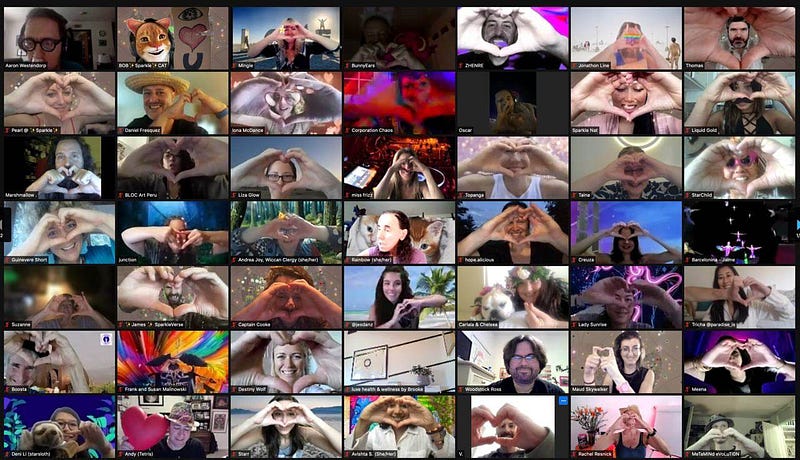 Participants
in the Closing Ceremony of Co-Reality Collective’s 2021 Official Burning Man Experience. How would
you convey this visual experience as an audio description? Click on the Alt text for our attempt.
Screen grab courtesy of Ben Lehman.
Participants
in the Closing Ceremony of Co-Reality Collective’s 2021 Official Burning Man Experience. How would
you convey this visual experience as an audio description? Click on the Alt text for our attempt.
Screen grab courtesy of Ben Lehman.Talking about the pencil sketches and 3D models he shared through description, VR Developer Whitt Sellers comments, “It still is a learning process around how to describe something I’m looking at or imagining in a helpful way. It was the first time where I’ve ever had to do that outside creative writing exercises in high school, describing a setting or a scene, and making it as rich as possible.”
Challenges in Creation and Curation
Our ability to design an effective audio landscape was hindered by several limitations inherent in the combination of Altspace with Unity. Basic game world functions like sonifying movement or collision, let alone directionality were impossible for someone navigating the experience solely through sound. Without these, large parts of the world felt confusing and lifeless. Audio from one pathway leaked into other spaces, confusing visitors’ sense of direction.
Our design process was further hindered by the lack of documentation around technical constraints such as file size and optimization. We needed to weigh the relative resource-intensity of an extra sound versus an extra image, the number of curves/polygons in our design versus the number of carefully placed audio beacons. Without this clarity, we had no reliable way to manage design trade-offs between vital navigational and descriptive sounds with our own creative ambitions around the gallery design and the breadth of our exhibition. Each artwork required an audio description, adding an extra layer to traditional gallerist challenges of curating our work.
Just before virtual Burning Man, a technical update led to the anomaly of visitors being unable to hear each other speak. Members of our team watched as visitors streamed through our gallery and Temple of Accessibility, pausing to look at our art and listen to our story. Unable to hear their responses to the exhibition beyond hand waves, shoulder shrugs and the limited emojis that survived the update, Creative Director Chris Hainsworth recalls this “feeling like the tech gods we had set out to provoke were having a laugh.”
Hopes for the Future
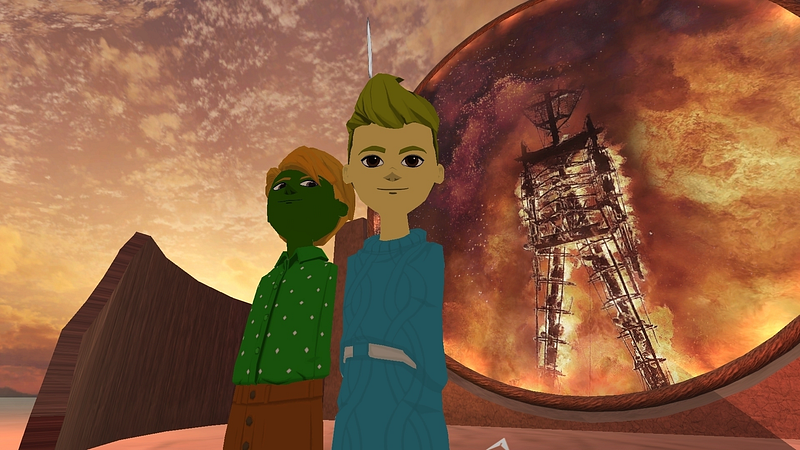 Marimuthu
and Chris from Blind Burners stand in front of the portal to virtual Burning Man in August
2021
Marimuthu
and Chris from Blind Burners stand in front of the portal to virtual Burning Man in August
2021Encouraged by the openness and responsiveness of some tech companies involved in VR platforms and creator tools, we hope that our work alongside that of others, such as the XR Access Initiative, will help to course-correct VR to a more inclusive future. We expect to see accessible user interfaces where blind and low vision individuals can log in, set up profiles and avatars, launch experiences, navigate worlds, create and connect. Fundamental change will only come when we establish clearer career paths for blind software engineers, designers, artists and sound designers.
As Blind Burners India Chapter Lead Marimuthu says, “People assume that visual arts are only done by sighted people, and I want to prove them wrong. We are blind people in Virtual Reality, it is us who are laughing.”
Fueled by our artist collective’s truly radical self-expression, inclusion and communal efforts, we invite our friends across global arts and technology to accompany us into virtual worlds beyond sight, into a future shaped by the intelligence, wisdom and creativity of blind and low vision artists.
This piece is part of Immerse’s 2023 issue centering disability innovation in documentary and emerging tech — presenting perspectives from artists, activists, scholars and technologists at the vanguard of storytelling and disability justice. You can find other featured stories and more information about the issue here.
For more news, discourse, and resources on immersive and emerging forms of nonfiction media, sign up for our monthly newsletter.
Immerse is an initiative of the MIT Open DocLab and Dot Connector Studio, and receives funding from Just Films | Ford Foundation, the MacArthur Foundation, and the National Endowment for the Arts. The Gotham Film & Media Institute is our fiscal sponsor. Learn more here. We are committed to exploring and showcasing emerging nonfiction projects that push the boundaries of media and tackle issues of social justice — and rely on friends like you to sustain ourselves and grow. Join us by making a gift today.